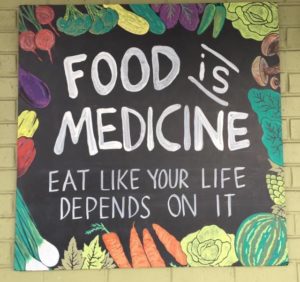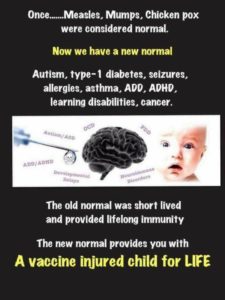Breastmilk is “Old-Fashioned” Eh?
Maybe this is why… Did you know that Albert Sabin, inventor of the oral polio vaccine, did the first study on the anti-polio properties of breast milk? He infected mice with polio and then took breast milk from 71 American women and fed it to the mice. The breast milk had an 84% success rate at neutralising polio. (Albert Sabin and Howard Fieldsteel, ‘Anti-poliomyelitic Activity of Human and Bovine Colostrum and Milk’, Journal of Pediatrics, 29 (1962).
Terrain Theory Validated – Germ Theory Invalidated
I distincly recall asking our local doctor in 1977, “How come Julie and I are exposed to the same germs, she gets sick and I don’t?”
His response? “She has sticky mucous.”
I had not read these books but these datums from them totally invalidate the germ/vaccination theory and confirms that the terrain is the principle determinant of wellness versus ill health. Keep the body exercised and well nourished and the frame of mind positive and you are more than half way there in my opinion!
In his disease classic, Nature Cure, Henry Lindlahr MD, referred to a French bacteriologist who examined the mouths of healthy, two month old infants, and found almost all the disease germs known to medical science. Yet these babies were healthy.
Henry Lindlahr, Nature : The unity of Acute Disease. 1922
https://soilandhealth.org/wp-content/uploads/GoodBooks/Lindlahr-%20Nature%20Cure-.pdf
Dr Henry Lindlahr again: During the 10 years that I have been connected with sanitarium work, my workers and myself, in giving the various forms of manipulative treatment, have handled intimately thousands of cases of infectious and contagious diseases, and I do not remember a single instance where any of us was was in the least affected by such contact. Ordinary cleanliness, good vitality, clean blood and tissues, the organs of elimination in good, active condition and, last but not least, a positive, fearless attitude of mind will practically establish natural immunity to the inroads and ravages of bacteria and disease taints. If infection takes place, the organism reacts to it though inflammatory processes, and by means of those endeavors to overcome and eliminate microorganisms and poisons from the system.”
Henry Lindlahr, Nature cure: The unity of Acute Disease 1922
https://soilandhealth.org/wp-content/uploads/GoodBooks/Lindlahr-%20Nature%20Cure-.pdf
Vaccine historian Eleanor McBean lived through the so-called 1918 flu pandemic. She stated:
“When the flu was at its peak, all the stores were closed as well as all the schools, businesses – even the hospital – as the doctors and nurses had been vaccinated too and were down with the flu. No one was on the streets. It was like a ghost town. We seemed to be the only family which didn’t get the flu; so my parents went from houses to house doing what they could to look after the sick, as it was impossible to get a doctor then. If it were possible for germs, bacteria, virus or bacilli to cause the disease, they had plenty of opportunityto attack my parents when they were spending many hours a day in sick rooms. But they didn’t get the flu and they didn’t bring any germs home to attack us children and cause anything. None of our family had the flu – not even a sniffle – and it was in the winter with deep snow on the ground.”
Eleanor McBean, ’Swine flu expose’
Dr Robert McCarrison spent many years observing the cycle of disease in animals. He recounts the following:
“In the course of my own work, I have seen dysentery arrise in ill fed monkeys while well fed monkeys living in the same animal room escaped; and I have seen ill fed pigeons become infected with contagiosum, while well fed birds living in their immediate vicinity escaped these infections. Other workers have had like experiences; the bacillus of mouse typhoid kills, on injection, over 90% of the ill fed mice while it kills less than 10% of the well fed mice; the ill fed mice are likewise less resistant to B. pestis cavide and to botulinus toxins.
Birds are rendered susceptible to infection by anthrax when fed on food deficient in vitamin B and rats to septic bronchpneumonia when fed on food deficient in vitamin A; guinea pigs, when fed on food deficient in vitamin C, die more readily from tuberculosis; new born calves deprived of colostrum develop nephritis due to B. Coli infection; swine suffer from tuberculosis, which can be irradicated from the herds by well balanced vitamin rich food; stock animals develop sarcosporidia from the same malnutritional cause.”
Robert McCarrison ’The disease of faulty nutrition’ at
http://journeytoforever.org/farm_library/medtest/medtest_mccarrison3.html
And here is an intersting read if you would like more data on what bacteria you are most likely to be harbouring at present!
Food Is Medicine

MORE than 2,000 years ago Hippocrates wrote as follows:
‘… it appears to me necessary to every physician to be skilled in nature, and to strive to know, if he would wish to perform his duties, what man is in relation to the articles of food and drink, and to his other occupations, and what are the effects of each of them to every one.
‘Whoever does not know what effect these things produce upon a man, cannot know the consequences which result from them.
‘Whoever pays no attention to these things, or paying attention, does not comprehend them, how can he understand the diseases which befall a man? For, by every one of these things a man is affected and changed this way and that, and the whole of his life is subjected to them, whether in health, convalescence, or disease. Nothing else, then, can be more important or more necessary to know than these things.’
It is strange that, although these words were written so long ago, it is only within the last quarter of a century that we have begun to pay attention to ‘what man is in relation to the articles of food and drink’, to ‘know what effect these things produce upon a man’, and, ‘to understand the diseases which befall a man’ in consequence of them.
I had not read this book but this datum from it totally validates the theory that it is not the germ but the terrain that is the principle determinant of wellness versus ill health. Keep the body exercised and well nourished and the frame of mind positive and you are more than half way there in my opinion!
Be Careful Introducing Foods
They Said These Were Safe Too

Why should we trust them about vaccines?
From Mike Stephenson (I’m sure he won’t mind my sharing)
1.3 million people went to U.S. emergency rooms in 2014 due to adverse prescription drug effects. Of these 124,000 died (about 10%). That means 1 in 2500 Americans died as a result of taking a prescription drug in a 12-month period. That’s almost one 9/11 event per week, all year long.
More than half of all Americans regularly take a prescription medication and each of these take four prescriptions on average.
I found the aforementioned data in the September issue of Consumer Reports which came in today’s mail. They cited the CDC and the FDA as sources.
Seems like a wild violation of the Hippocratic Oath of “First do no harm.”
I wonder how many people have been rushed to ERs due to adverse reactions from vitamins and nutritional supplements? According to Mercola.com, in 2010 there were 60 billion doses of nutritional supplements and ZERO deaths! Dr. Mercola cited the U.S. National Poison Data System’s annual report.
A telling tale!
And the TGA here in Australia want to restrict complimentary medicines?
Sounding more and more like monopolistic practices to me.
Does not appear to have anything to do with protecting the public.
Tough trade-off!
Vaccines Paralyse Monkeys
Not My Circus, Not My Monkeys
Is What You Are Told True?
Cecile posted a wonderful quote this week from Carl Sagan that was never so apt as when applied to those scammed by the medical profession into thinking that vaccinations were the result of the drop in infectious diseases:
One of the saddest lessons of history is this: If we’ve been bamboozled long enough, we tend to reject any evidence of the bamboozle. We’re no longer interested in finding out the truth. The bamboozle has captured us. It’s simply too painful to acknowledge, even to ourselves, that we’ve been taken. Once you give a charlatan power over you, you almost never get it back.
There is a quote to the same effect, attributed to Mark Twain but allegedly unproven as penned by him.
“It’s easier to fool people than to convince them that they have been fooled.”
Despite the disputes over it’s authenticity, it is, unfortunately, observably true!
So next time somebody presents you with data conrary to what you have previously been told, it might pay to stop and fact check the contrary data. And relying on daya presented by an “authority” as being more valid is very often a lazy and incorrect choice. Especially if they are asking you to trust their authority rather than actually looking for your self.
You cannot live long enough in one lifetime to learn all you need to know by direct observation, so you have to take in a great deal of data second hand, that is written by someone else who observed. But you do have to exercise more judgement with second hand data than you do with that you directly observe. One thing you have to ask is, “Is there a slant being given, is there a vested interest being forwarded with this data.”
Indian Independence: Forged in Washington?
India commemorates the end of British rule 70 years ago on 15 August. Now might be an apt moment to consider where India might be heading, especially given recent developments. If one policy stands out over the past 12 months, it would have to be demonetisation.
Removing all 500- and 1000-rupee notes from circulation overnight was in part a bail out for the banks. It injected much needed liquidity into the banking system that had been bled dry by the outflow of cheap money (and loan waivers) to large corporations which had been milking the well dry. You can read about this here and here. However, the other aspect of demonetisation which will be focused on in this article, is that it also formed part of a push for a cashless society and the wider global ‘war on cash’.
Demonetisation was a massive, ill-thought-out experiment that was destined in a place like India to cause immense hardship for most of the population who rely on cash transactions. Economist Norbert Haring provides insight into the wider policy machinations of a Washington-based elite that fuelled demonetisation and which went over the heads of the hundreds of millions who would be affected.
Based on what took place, it is not too far off the mark to suggest that, courtesy of a handful of strategically placed figures within India, the Indian state is being co-opted into a CIA-Pentagon-Wall Street nexus of global domination by surrendering financial sovereignty and curtailing the individual freedoms of Indian citizens.
Demonetisation and international capital
The shift from cash towards digital transactions is being spearheaded by Bill Gates and US financial corporations who will profit from the mark up on digital payments. Modi is seemingly a willing partner in this. His brand of nationalism is a cheap diversionary con-trick to make India a fully paid up client state of the US. Control food you control people. Control digital payments (and remove cash), you can control and monitor everything a country and its citizens do and pay for.
The Gates Foundation is a prominent proponent of the global ‘war on cash’, and Bill Gates has the backing of some heavy hitters: the big banks and likes of PayPal, Citi, Visa and Mastercard all smell huge profits in this.
Haring notes that the cooperation of the Gates foundation and the Reserve Bank of India (RBI) is a very tight one. For example, Nachiket Mor, a ‘Yale World Fellow’, is head of the Gates Foundation India. He is also a board member of the RBI with responsibility for financial supervision.
Apart from More and Modi, there are also other key individuals with their hands on the relevant levers of power in India to do Washington’s bidding. For instance, there is Avrind Subramanian, the chief economic advisor to the government, and Raghuram Rajan, who was until recently Governor of the Reserve Bank of India. He was chief economist at the International Monetary Fund from 2003 to 2007 and was a Distinguished Service Professor of Finance at the University of Chicago Booth School of Business from 1991 to 2013. He is now back at the University of Chicago.
Aside from Rajan acting as a mouthpiece for Washington’s strategy to recast agriculture in a corporate image and get people out of farming in India, Haring implicates Rajan in the demonestisation policy. He indicates that the policy was carried out on behalf of USAID, MasterCard, Visa and the people behind eBay and Citi, among others, with support from the Gates Foundation and the Ford Foundation.
Haring calls Rajan the Reserve Bank of India’s “IMF-Chicago boy” and based on his employment record, memberships (not least of the elite Group of Thirty which includes heads of central, investment and commercial banks) and links, place him squarely at the centre of Washington’s financial cabal.
Securing payments that accrue from each digital transaction would of course be very financially lucrative for the financial institutions pushing for a cashless world. However, for a low income country such as India, which runs on cash, the outcomes so far have been catastrophic for hundreds of millions of people, especially those who don’t have a bank account (almost half the population) or do not even have easy access to a bank.
Regardless of the effects on ordinary people, demonetisation used the Indian population as a collective guinea pig to see how far the interests of international finance capital could be secured. The ultimate aim seems to be to displace the informal (i.e. cash-bashed and self-organised) economy with Western corporations and with supply chains controlled by them.
Co-opting the development paradigm
Development used to be about breaking with colonial exploitation and radically redefining power structures. Now we have dogma masquerading as economic theory that compels developing countries to adopt neo-liberal policies. The notion of ‘development’ has become hijacked by rich corporations and the concept of poverty depoliticised and separated from structurally embedded power relations.
Whereas some want to bring about a fairer, more equitable system of production and distribution to improve people’s quality of lives (particularly pertinent in India with its unimaginable inequalities which have spiralled since India adopted neoliberal policies), Washington and its unelected oligarchs like Bill Gates regard ‘development’ as a way to further US interests globally. Whether it involves aid, investment, trade deals (not least the Knowledge Initiative on Agriculture) or other partnerships, development and economic and strategic US self-interests are one and the same.
Haring notes that it is US policy to:
“… promote and elevate development as a core pillar of American power and chart a course for development, diplomacy, and defense to reinforce and complement one another. As stated in the 2010 National Security Strategy and the Presidential Policy Directive on Global Development, the successful pursuit of development is essential to advancing our national security objectives.”
He adds that the start of the direct cooperation of the Gates Foundation with the Reserve Bank of India on digital payments coincides with the work of the Gates foundation in the President’s Global Development Council, which was to promote cooperation with foreign governments and the private sector with a view to US defence and commercial interests.
Haring says:
“Bill Gates gave an example of the link between worldwide digitalization of payments (via the large US payment companies) and US security interests in his speech in 2015. Talking about the problem that overly strict rules for payment providers might do the opposite of the intended: “If financial flows go into a digital system that the US is not connected to, it becomes much harder to find those transactions that you want to be aware of or you want to block”.”
In a recent report on the digitalization of the Indian payment system, Haring notes that Boston Consulting Group and Google urged payment providers to “Mine customer data to build additional revenue streams.” They promise that mining customer data will help them to manipulate consumers into buying more. “Payments will drive consumption – and not the other way around.”
On the steering board of the study were Visa and Vodafone (M-Pesa). These days, the government of Kenya, Bill Gates’ poster-child for financial inclusion, is trying to force mobile phone providers to give them the opportunity to monitor all phone calls and mobile payments. They are telling the phone companies to let a contracted (private) company hook up to all routers.
So, apart from increasing the (unconstitutional) surveillance capabilities of the Indian state (and Washington), what we are seeing is a push for a consumer-based model of development driven by some of the world’s largest corporate players: a model of capitalist development that is corrupt and unsustainable and by its very nature leads to environment catastrophe:
“… our economic system demands ever-increasing levels of extraction, production and consumption. Our politicians tell us that we need to keep the global economy growing at more than 3% each year – the minimum necessary for large firms to make aggregate profits. That means every 20 years we need to double the size of the global economy – double the cars, double the fishing, double the mining, double the McFlurries and double the iPads. And then double them again over the next 20 years from their already doubled state.” – Jason Hickel, writing in The Guardian.
Capitalism and environmental catastrophe joined at the hip
Whether it is the war on cash, massive loan waivers and hand-outs for corporates, demonetisation, mining data, creating revenue streams or the fixation on consumption and endless growth, the prevailing paradigm is blind faith in a failed neoliberal globalisation and a ‘free’ market that exists only in the warped delusions of its supporters.
And for what is still an agrarian society, the plan for India’s countryside follows the same path. There is a plan to displace the majority of India’s rural population in the coming years. Hundreds of millions which will be shifted to the cities. A 2016 UN report said that by 2030, Delhi’s population will be 37 million. Quoted in The Guardian, the report’s principal authors, Felix Creutzig, says:
“The emerging mega-cities will rely increasingly on industrial-scale agricultural and supermarket chains, crowding out local food chains.”
In India, the push to drive at least 400 million from the land and into cities is already underway at the behest of the World Bank which India is heavily indebted to: a World Bank that is, under the guise of ‘enabling the business of agriculture’, committed to opening up economies to corporate seeds and agrochemicals and securing global supply chains for transnational agribusiness from field to plate. The drive is to entrench industrial farming, commercialise the countryside and to replace small-scale farming, the backbone of food production in India (and globally).
If current policies continue, it could mean hundreds of millions of former rural dwellers without any work. Moreover, given the trajectory the country seems to be on, it does not take much to imagine vast swathes of chemically-drenched monocrop fields containing genetically modified plants or soils rapidly turning into a chemical cocktail of proprietary biocides, dirt and dust.
Thanks to the model of agriculture being supported and advocated by neoliberal ideologues (again, with Bill Gates and his ‘corporate America’ entourage to the fore) under the banner of ‘growth’, it also does not take much to imagine a state of near-permanent drought, spiralling rates of illness throughout the population due to bad diets, denutrified food and agrochemical poisoning. Industrial agriculture will be the norm (with all the social, environmental and health devastation and externalised costs that the model brings with it).
Look no further than the current situation in South India and the drying up of the Cauvery river in places to see the impact that chemical-intensive farming has already had. What is happening there is a farming and ecological crisis partly fuelled by environmental devastation due to mining, deforestation and unsustainable agriculture based on big dams, water-intensive crops and Green Revolution ideology imported from the West. Wrong-headed policies have resulted in drought, population displacement and degraded soils. The rivers are dying, farmers are dying (and killing themselves due to them being “at the mercy of global economics“) and the cities cannot be sustained. The solutions (also see this about Bhaskar Save) are there for all to see, but still they are not being taken seriously. It’s a catastrophe that’s rapidly unfolding.
Since the 1990s, India seems to have decided to hitch a ride to the future by tying itself to a US-led system of neoliberal globalisation, an unsustainable, crisis- and conflict-ridden system that fuels national debt and relies on hand-outs for banks and corporations.
It’s a system based on a credit/debt-based consumer economy, financial speculation, derivatives and bubbles, with nations no longer able to carry out their own policies, tied down by undemocratic trade deals, beholden to rigged World Trade Organization rules and following a path prescribed by the World Bank.
India is under siege from international capital. It is not only on course to become an even weaker and more hobbled state permanently beholden to US state-corporate interests, but it is heading towards environmental catastrophe much faster than many may think. You do not have to imagine the eventual outcome; visit the Cauvery, the reality has already taken hold.
Join the debate on Facebook
More articles by:Colin Todhunter
Colin Todhunter is an extensively published independent writer and former social policy researcher based in the UK and India.
https://www.counterpunch.org/2017/07/31/indian-independence-forged-in-washington/




